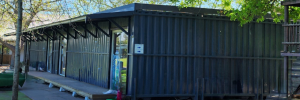
Temperature conditions poor, CO2 levels high in container classrooms – SU study
South Africa's school children already face a swathe of socio-economic challenges. To make matters worse, some learners must sit in container (converted shipping containers) and mobile (prefabricated) classrooms where temperatures are unacceptably high in the summer and low in the winter. In addition, the carbon dioxide (CO2) levels inside container classrooms are so high that they impact their academic performance and health.
This is according to a study by researchers in the Faculty of Engineering at Stellenbosch University (SU).
They measured CO2 levels and temperatures in 24 classrooms – container classrooms with and without insulation, mobile classrooms and brick or permanent classrooms – at two schools in Stellenbosch over 12 months. They installed sensors in the classrooms that were powered with a power bank as battery backup to ensure uninterrupted measurements during load shedding.
“Our research shows that container classrooms have the worst temperatures and air quality even when air conditioning is available. The air quality in mobile classrooms is better, but the temperature control is poor. Brick classrooms offer the best temperature regulation and air quality," says lead researcher and PhD candidate Rita van der Walt from the Department of Electrical and Electronic Engineering at SU. She conducted the study with supervisors Prof Thinus Booysen (research chair holder in the Internet of Things at the Faculty of Engineering) and Prof Sara Grobbelaar (Department of Industrial Engineering).
The study was published recently in the Journal of Cleaner Production.
The researchers point out that although temperature and CO2 levels are important for air quality and can directly affect learners' thinking, academic performance, motivation, health and comfort, they have not been studied in different types of classrooms. “Mobile and container classrooms are widely used as permanent classrooms in our schools, but no current research measures the potentially poor indoor air conditions in these classrooms."
They say their results show that “temporary classrooms have temperatures ranging from 5,3°C to 40,6°C on school days, while permanent classrooms are more stable, with temperatures between 11,2°C and 33,5°C. The measured temperature range is 13°C greater for temporary classrooms than permanent classrooms. Throughout the year, temporary classrooms are at least 10°C hotter or colder than permanent classrooms.
“These results suggest that the poor temperature conditions in temporary classrooms, due to bad insulation and infrastructure, are not adequately improved by the current air control and heating, ventilation and air conditioning (HVAC) systems during school days."
As far as CO2 concentrations are concerned, they are substantially worse in container classrooms with mobile classrooms having better conditions compared to brick classrooms, according to the researchers.
“During winter, when doors and windows are usually closed, container classrooms had much higher CO2 levels than mobile classrooms. Overall, container classrooms consistently have higher daily CO2 concentrations than mobile classrooms throughout the year.
“We noticed that CO2 levels increased when classrooms were occupied before, between and after breaks. The greatest CO2 spike occurred in the morning. This shows that the number of people in a room significantly affects CO2 levels. After school, CO2 levels dropped once the classrooms were empty.
“In classrooms with only air conditioning and no ceiling fans, container classrooms with and without insulation had CO2 levels above 1 000 parts per million (ppm) on 50% and 24% of school days, respectively. In comparison, mobile classrooms exceeded this level on just 11% of school days."
The researchers add that brick classrooms equipped with ceiling fans but no aircon have significantly lower indoor CO2 concentrations than brick classrooms equipped with a ceiling fan and aircon, throughout the year. This is because windows and doors are kept closed for air conditioning to work effectively, but not for ceiling fans.
They point out that the World Health Organization recommends maintaining CO2 levels below 1 000 ppm in indoor spaces for adequate ventilation and good air quality. Breathing in air with CO2 levels above 1 000 ppm is like being in a crowded elevator where everyone is exhaling heavily. It is stuffy and uncomfortable, and could cause drowsiness, difficulty concentrating, or headaches.
According to the researchers, the design and construction of classrooms greatly influence the indoor air quality, including temperature and CO2 levels.
“The type of classroom structure mostly determines the temperature conditions, while the HVAC system mainly affects CO2 levels. This suggests that ventilation improvements are needed when converting shipping containers into classrooms. In contrast, mobile classrooms are usually designed with proper ventilation because they will be occupied by people."
The researchers say schools are still being equipped with mobile classrooms with some using container classrooms as permanent classrooms due to their cost effectiveness. These classrooms are prevalent in nearly all public schools, including high-income (quintile 5) schools.
They propose adding thermal insulation and redesigning spaces to help manage temperature swings in classrooms.
“Invest in HVAC systems that fit the specific needs of different classroom types, especially container classrooms, which lack natural ventilation. And retrofitting existing HVAC systems can also improve ventilation and air quality.
“Guidelines and standards must be developed for different types of classrooms, especially temporary ones, to ensure effective construction and renovation. This should include thermal insulation and prioritising natural ventilation strategies."
- Source: R.E. van der Walt, S.S. Grobbelaar, M.J. Booysen (2024). Indoor temperature and CO2 in South African primary school classrooms: Inspecting brick, container, and prefab structures. Journal of Cleaner Production: DOI: 10.1016/j.jclepro.2024.143120
